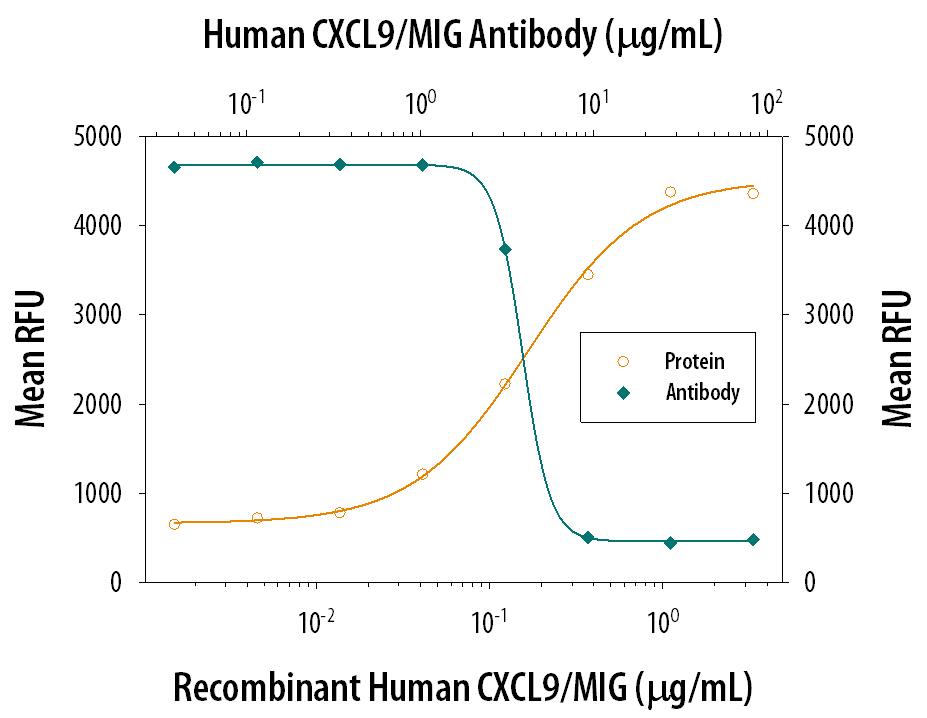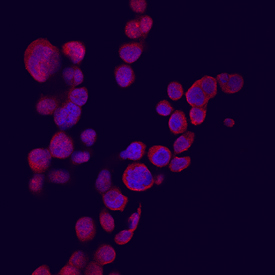Human CXCL9/MIG Antibody Summary
Thr23-Thr125
Accession # Q07325
Applications
Please Note: Optimal dilutions should be determined by each laboratory for each application. General Protocols are available in the Technical Information section on our website.
Scientific Data
 View Larger
View Larger
Chemotaxis Induced by CXCL9/MIG and Neutral-ization by Human CXCL9/ MIG Antibody. Recombinant Human CXCL9/ MIG (392-MG) chemo-attracts the BaF3 mouse pro-B cell line transfected with mouse CXCR3 in a dose-dependent manner (orange line). The amount of cells that migrated through to the lower chemotaxis chamber was measured by Resazurin (AR002). Chemotaxis elicited by Recombinant Human CXCL9/ MIG (1 µg/mL) is neutralized (green line) by increasing concentrations of Goat Anti-Human CXCL9/MIG Antigen Affinity-purified Polyclonal Antibody (Catalog # AF392). The ND50 is typically 5-40 µg/mL.
 View Larger
View Larger
CXCL9/MIG in THP‑1 Human Cell Line. CXCL9/MIG was detected in immersion fixed THP-1 human acute monocytic leukemia cell line stimulated with IFN-gamma using Goat Anti-Human CXCL9/MIG Antigen Affinity-purified Polyclonal Antibody (Catalog # AF392) at 10 µg/mL for 3 hours at room temperature. Cells were stained using the Northern-Lights™ 557-conjugated Anti-Goat IgG Secondary Antibody (red; Catalog # NL001) and counter-stained with DAPI (blue). View our protocol for Fluorescent ICC Staining of Cells on Coverslips.
Reconstitution Calculator
Preparation and Storage
- 12 months from date of receipt, -20 to -70 °C as supplied.
- 1 month, 2 to 8 °C under sterile conditions after reconstitution.
- 6 months, -20 to -70 °C under sterile conditions after reconstitution.
Background: CXCL9/MIG
CXCL9, a member of the alpha subfamily of chemokines that lack the ELR domain, was initially identified as a lymphokine-activated gene in mouse macrophages. Human CXCL9 was subsequently cloned using mouse MIG cDNA as a probe. The CXCL9 gene is induced in macrophages and in primary glial cells of the central nervous system specifically in response to IFN-gamma. CXCL9 has been shown to be a chemoattractant for activated T-lymphocytes and TIL but not for neutrophils or monocytes. The human CXCL9 cDNA encodes a 125 amino acid residue precursor protein with a 22 amino acid residue signal peptide that is cleaved to yield a 103 amino acid residue mature protein. CXCL9 has an extended carboxy-terminus containing greater than 50% basic amino acid residues and is larger than most other chemokines. The carboxy-terminal residues of CXCL9 are prone to proteolytic cleavage resulting in size heterogeneity of natural and recombinant CXCL9. CXCL9 with large carboxy-terminal deletions have been shown to have diminished activity in the calcium flux assay. A chemokine receptor (CXCR3) specific for CXCL9 and IP-10 has been cloned and shown to be highly expressed in IL-2-activated T-lymphocytes. The E. coli-expressed CXCL9 preparations produced at R&D Systems have been shown to contain greater than 80% full length CXCL9.
- Loetscher, M. et al. (1996) J. Exp. Med. 184:963.
- Liao, F. et al. (1995) J. Exp. Med. 182:1301.
- Vanguri, P. (1995) J. Neuroimmunol. 56:35.
Product Datasheets
Citations for Human CXCL9/MIG Antibody
R&D Systems personnel manually curate a database that contains references using R&D Systems products. The data collected includes not only links to publications in PubMed, but also provides information about sample types, species, and experimental conditions.
10
Citations: Showing 1 - 10
Filter your results:
Filter by:
-
Lack of CD8+ T-cell co-localization with Kaposi's sarcoma-associated herpesvirus infected cells in Kaposi's sarcoma tumors
Authors: SJ Lidenge, FY Tso, O Ngalamika, J Kolape, JR Ngowi, J Mwaiselage, C Wood, JT West
Oncotarget, 2020-04-28;11(17):1556-1572.
Species: Human
Sample Types: Whole Tissue
Applications: IHC-P -
CXCR3 Blockade Inhibits T Cell Migration into the Skin and Prevents Development of Alopecia Areata
J Immunol, 2016-07-13;0(0):.
Species: Human
Sample Types: Whole Tissue
Applications: IHC-P -
Intracellular coexpression of CXC- and CC- chemokine receptors and their ligands in human melanoma cell lines and dynamic variations after xenotransplantation.
Authors: Pinto S, Martinez-Romero A, O'Connor J, Gil-Benso R, San-Miguel T, Terradez L, Monteagudo C, Callaghan R
BMC Cancer, 2014-02-22;14(0):118.
Species: Human
Sample Types: Whole Cells
Applications: ICC -
Expression and regulation of chemokines in murine and human type 1 diabetes.
Authors: Sarkar SA, Lee CE, Victorino F, Nguyen TT, Walters JA, Burrack A, Eberlein J, Hildemann SK, Homann D
Diabetes, 2011-12-30;61(2):436-46.
Species: Human
Sample Types: Whole Cells
Applications: Flow Cytometry -
Myocarditis in CD8-depleted SIV-infected rhesus macaques after short-term dual therapy with nucleoside and nucleotide reverse transcriptase inhibitors.
Authors: Annamalai L, Westmoreland SV, Domingues HG
PLoS ONE, 2010-12-23;5(12):e14429.
Species: Primate - Macaca mulatta (Rhesus Macaque)
Sample Types: Whole Tissue
Applications: IHC-P -
Inflammation and tissue repair markers distinguish the nodular sclerosis and mixed cellularity subtypes of classical Hodgkin's lymphoma.
Authors: Birgersdotter A, Baumforth KR, Porwit A, Sjoberg J, Wei W, Bjorkholm M, Murray PG, Ernberg I
Br. J. Cancer, 2009-09-22;101(8):1393-401.
Species: Human
Sample Types: Whole Tissue
Applications: IHC -
Villitis of unknown etiology is associated with a distinct pattern of chemokine up-regulation in the feto-maternal and placental compartments: implications for conjoint maternal allograft rejection and maternal anti-fetal graft-versus-host disease.
Authors: Kim MJ, Romero R, Kim CJ, Tarca AL, Chhauy S, LaJeunesse C, Lee DC, Draghici S, Gotsch F, Kusanovic JP, Hassan SS, Kim JS
J. Immunol., 2009-03-15;182(6):3919-27.
Species: Human
Sample Types: Whole Tissue
Applications: IHC-Fr -
Ultraviolet radiation-induced injury, chemokines, and leukocyte recruitment: An amplification cycle triggering cutaneous lupus erythematosus.
Authors: Meller S, Winterberg F, Gilliet M, Muller A, Lauceviciute I, Rieker J, Neumann NJ, Kubitza R, Gombert M, Bunemann E, Wiesner U, Franken-Kunkel P, Kanzler H, Dieu-Nosjean MC, Amara A, Ruzicka T, Lehmann P, Zlotnik A, Homey B
Arthritis Rheum., 2005-05-01;52(5):1504-16.
Species: Human
Sample Types: Whole Tissue
Applications: IHC-Fr -
Classification of distinct subtypes of peripheral T-cell lymphoma unspecified, identified by chemokine and chemokine receptor expression: Analysis of prognosis.
Authors: Ohshima K, Karube K, Kawano R, Tsuchiya T, Suefuji H, Yamaguchi T, Suzumiya J, Kikuchii M
Int. J. Oncol., 2004-09-01;25(3):605-13.
Species: Human
Sample Types: Whole Tissue
Applications: IHC-P -
Imbalance in the expression of CXC chemokines correlates with bronchoalveolar lavage fluid angiogenic activity and procollagen levels in acute respiratory distress syndrome.
Authors: Keane MP, Donnelly SC, Belperio JA, Goodman RB, Dy M, Burdick MD, Fishbein MC, Strieter RM
J. Immunol., 2002-12-01;169(11):6515-21.
Species: Human
Sample Types: BALF, Whole Tissue
Applications: ELISA Development, IHC-P
FAQs
No product specific FAQs exist for this product, however you may
View all Antibody FAQsReviews for Human CXCL9/MIG Antibody
There are currently no reviews for this product. Be the first to review Human CXCL9/MIG Antibody and earn rewards!
Have you used Human CXCL9/MIG Antibody?
Submit a review and receive an Amazon gift card.
$25/€18/£15/$25CAN/¥75 Yuan/¥2500 Yen for a review with an image
$10/€7/£6/$10 CAD/¥70 Yuan/¥1110 Yen for a review without an image


